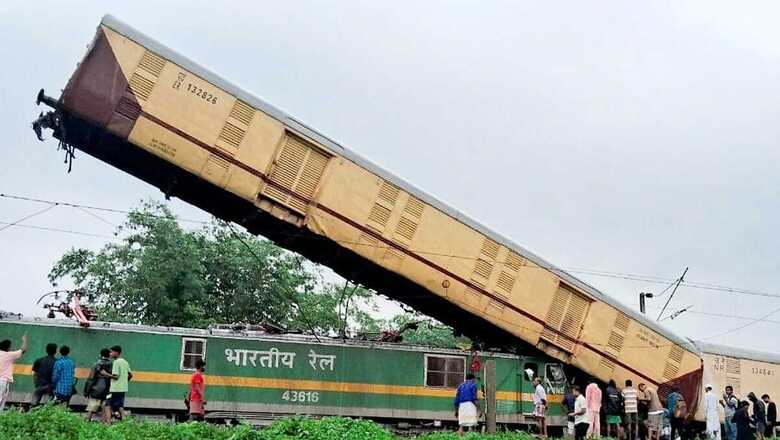
views
In the context of the recent tragic railway accident in New Jalpaiguri, West Bengal, which resulted in the loss of at least 15 lives, there has been a growing call from Opposition parties for Railway Minister Ashwini Vaishnaw to step down, citing moral responsibility.
Given the vast and complex nature of the Indian Railways, one of the largest networks in the world, it raises an important question: Should the responsibility for such accidents rest solely on the shoulders of a single minister?
Considering the scale and intricacies involved in managing this enormous transportation system, it can be argued that the solution isn’t the sacking of the individual who holds the top position. Instead, a thorough examination and systemic approach could offer more substantial answers to improving railway safety and accountability.
Having said that, does moral responsibility count for much in 2024?
Through the decades, India has had a long history of grim and gruesome rail disasters. But so far only two ministers — Lal Bahadur Shastri and Nitish Kumar — have resigned.
Shastri resigned twice after accidents in 1956. When he quit in August 1956 after 112 people died, the then Prime Minister, Jawaharlal Nehru, refused to accept it. Three months later, 144 people died in another accident. Shastri wanted to go “quietly”. Nehru reluctantly agreed.
Nitish Kumar resigned in 1999 after 290 people died in the Gaisal (West Bengal) accident. But, he was back as Railway Minister two years later.
Mamata Banerjee offered to quit in 2000 after a train accident in Punjab killed 43 people. The then Prime Minister, Atal Bihari Vajpayee, refused to let her go. She was back as Railway Minister in the UPA government later.
Suresh Prabhu, after a series of accidents, offered to quit but it was rejected. One of the accidents killed 150 people near Kanpur. He was shifted to Ministry of Commerce and Industry.
Owning moral responsibility is one thing but making the rail sector safe for travel is another. Ashwini Vaishnaw is a highly experienced bureaucrat-cum-technocrat. He was a good pick to head Railways as India tries to revamp and modernise this vital Sector. Vaishnaw is from IIT Kanpur, a former IAS officer, entrepreneur, and has had the experience of working with some of India’s top politicians.
For several decades now, the Indian Railways have grappled with insurmountable challenges such as ageing infrastructure, perennial overcrowding, size and complexity and lack of sufficient modernisation and safety measures.
Regarding the latest accident in West Bengal, Railway Board CEO Jaya Varma Sinha said that the Kavach system, which protects trains from accidents, was not in place on the particular route.
Reports say the passenger train was stationary on the tracks when the goods train rammed into it. The rear compartments of the Kanchanjunga Express were mostly carrying cargo hence the death toll has been mercifully low.
What is the Kavach system?
The Research Design and Standards Organisation (RDSO) created the armour-like Kavach anti-collision technology with the intention of achieving “zero accidents”. It is the least expensive automatic train collision prevention technology, according to the railways.
The technology possesses the highest certification level: Safety Integrity Level 4 (SIL-4) certification. It indicates that there is a 10,000-year chance of only one Kavach mistake.
In 2022-23, the government intended to bring 2,000 kilometres of the train network under Kavach. The goal was for the system to encompass over 34,000 km of train infrastructure.
But since the initial field testing on the passenger trains began in February 2016, the Railways have so far implemented the Kavach system on 1,465 route kilometres and 139 locomotives (including Electric Multiple Unit rakes) on the South Central Railway, having tendered 6,000 km of the system.
Upgrades include 100 per cent electrification of railways, upgrading existing lines with more facilities and higher speeds, expansion of new lines, upgrading railway stations, introducing and eventually developing a large high-speed train network.
The modernisation plan of railways includes an investment of Rs 10-12 lakh crore over the next five years for transforming Railways with modern world-class facilities. But there are endemic problems too.
India’s railway tracks are burdened by too many passenger trains often leading to route congestion. Since freight and passenger trains use the same network (barring a few dedicated freight corridors) more than 40 per cent of Indian Railways’ sections are used beyond 100 per cent capacity.
There is a lack of security consciousness in the railway administration, and efforts to control access to stations have not been adequate. For example, many stations have multiple entry and exit points, making it difficult to restrict entry.
Official reports said that there could be poor coordination between railway security forces, police, and intelligence agencies. Incorporation of technologies like machine learning, biometric authentication and unmanned aerial vehicles (drones) can improve surveillance and enhance security.
The latest accident highlights the need for:
- Adoption of advanced technologies
- Install anti-collision devices (ACDs) such as Kavach/ Train Collision Avoidance System (TCAS)
- Train Protection Warning System (TPWS)
- Automatic Train Control (ATC)
The time is ripe for the Railways to improve their safety and security mechanism.
Arup Ghosh is CEO of nnis, media entrepreneur and columnist. Views expressed in the above piece are personal and solely those of the author. They do not necessarily reflect News18’s views.




















Comments
0 comment